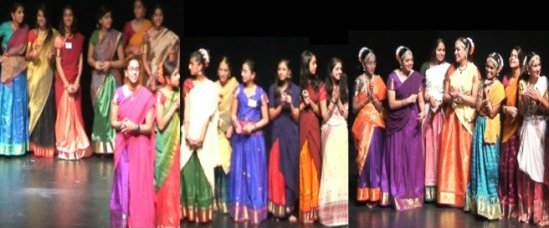
Natya 2009:
Rich exchange of performances and ideas
- Lata Ganesh,
Washington DC
May 7,
2009
The Natya 2009
music/dance conference on March 14, 2009 held at Towson University, MD,
was hosted by Jayamangala, a non-profit organization in Maryland, co-sponsored
by Indian Dance Educators Association (IDEA in DC) and the Theater dept.
of Towson University, in Baltimore MD. The event was extremely informative
and interesting as it brought together various experts in Indian classical
dance styles to participate in lectures, performances, panel discussion
and a concluding Natya Quiz for students of dance. In addition to
bringing out the traditional aspects of classical Indian dances, the performers
at this conference were extremely creative in trying to link traditional
art forms to contemporary music. The conference also showcased
the keen interest and enthusiasm of the young artistes in understanding
the classical dance forms. Beginning with Natya 101, an introduction
to various Indian classical dance styles, some of the presentations were:
The Dhananjayans'
Nrityopahaaram presented by Puneet Panda was a lively performance that
combined technique, grace and storytelling! Natyabhoomi's 'Natya in Laya'
was an interesting choreography where interpretation of the same music
by two distinctive styles of dancers was exhibited. The classical Indian
dance by Anita Sivaraman was flawless. This versatile artiste is
a role model for young and upcoming students of Bharatanatyam style of
dancing.
'Carvings in
Bharatanatyam' by Ranidevi's school Kalairani Natya Saalai was very educative.
The demonstration of the 108 karanas by the group was truly amazing! It
is a tribute to Guru Ranidevi that her students' performance reflected
their keen technical understanding and certainly reflective of their intense
training and practice.
'Comptemporizing
Natya' by Jayamangla was a treat to watch. Amjad Ali Khan once said, "What
matters is that the listener enjoys the music and not whether he recognizes
and appreciates the technical aspects or not!" The Jayamangala performance
skillfully presented how a classical dance could be adapted to contemporary
music and lyrics that effectively connect with the audience.
Indian opera,
Geya Nrutya by Prasanna Kasthuri was entertaining, interactive and educative.
The demonstration-performance gave the audience an understanding to closely
relate the lyrical story with expressive movements.
'Thevaram' by
Janaki Rangarajan gave us a rare insight to the devotional hymns, their
beauty, meaning, structure and the musical scales - Panns, as they were
called - which have their equivalent to ragas of Indian classical music.
This performance was a demonstration of how ancient hymns can be expressed
through the medium of Bharatanatyam.
'Rhythms of Love'
by Kala Shahi was a pleasing performance where the dancers gracefully and
elegantly expressed the theme of their piece, 'love.' It was interesting
to notice the movements and gestures unique to Mohiniattam.
One of the
panelists Sahasra Sambamoorthi, a Bharatanatyam dancer from New Jersey,
felt that "the conference was informal, relaxed, and informative.
It had a mixture of both information for beginners and interesting innovations
and theories about the field." Another panelist Michele Minnick, faculty
member of the Towson Theatre department congratulated the south Asian community
in DC on a very well attended and successful event. "It was a rich
exchange of performances and ideas across the spectrum of traditional Indian
dance. I enjoyed it immensely and felt privileged to take part in the conversation."
The panel discussion
'Burden of Tradition' was moderated by Christel Stevens and featured Kuchipudi
dancer Anuradha Nehru, Michele Minnick, and Sahasra Sambamoorthi. Prof.
Stephen Nunns, Director of MFA program at Towson's theater dept. called
it "a fantastic event, one of the most unique things I've seen in a while.
And pulled off to perfection."
 The finale Quiz at Natya 2009 organized by Rani Devi included an
on-the spot choreography for dance students of DC metro.
It was heartening to see many of the teenager participants dressed
in traditional half-sarees.
The finale Quiz at Natya 2009 organized by Rani Devi included an
on-the spot choreography for dance students of DC metro.
It was heartening to see many of the teenager participants dressed
in traditional half-sarees.
|
"What a great
way of bringing the microcosm of Indian dance and culture together!
I felt immersed in the collective beauty, power, and challenges of Indian
dance." These words by Pallabi Chakravorti, Kathak dancer and Professor
at Swarthmore College, PA, summed up the feelings of most people who attended
the event. |

